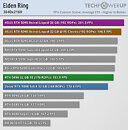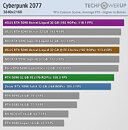Tuesday, April 1st 2025

Surprise Reversal: GeForce RTX 5090 Found with Too Many ROPs, Matches RTX Pro 6000, +8% Performance
NVIDIA's stellar quality control with the $2,000 GeForce RTX 5090 saw quite a few customers end up with cards that had fewer ROPs than they should—168 as opposed to its original spec of 176. The 8 fewer ROPs results in a roughly 5% drop in performance. When you're ponying up over two grand, this is the last thing you want. But what if we told you there are cards out there were more ROPs than they should have? We have with us an ASUS ROG Astral GeForce RTX 5090 LC graphics card that we detected 192 ROPs on. That's right, the card has all the 192 ROPs active that are present in the "GB202" silicon, or two ROP partitions (16 ROPs) more than it should have. We received our ROG Astral RTX 5090 LC sample just a few weeks ago, and haven't had time to thoroughly test it yet, because we're in the middle of a full retest with new games and new drivers.
The ASUS ROG Astral LC is a factory overclocked card, with ASUS giving the card a generous OC to benefit from the liquid cooling solution (2580 MHz boost vs. 2407 MHz reference or +7.1%). To account for that, we tried our best to clock the card back down to reference specs, which is presented as the orange bar. This still isn't the same card as the RTX 5090 Founders Edition, because the superior cooling solution and power limits mean that the GPU enjoys better boost frequency residency, but this is as close as we can get to simulating reference spec. We ran the card through a battery of game tests, which show an average of 8% performance gains over the RTX 5090 Founders Edition.We can conclude that at least some of this performance gain is thanks to the additional ROPs. We are not sure how the performance scales with ROP count—if you recall, the loss of 8 ROPs resulted in a 5% performance drop, however a gain of 16 ROPs only results in an 8% gain (also accounting for other factors such as superior cooling and power limits). As for performance out of the box, our sample tests a whopping 12% faster than Founders Edition, bringing this much closer to an "RTX 5090 Ti." On the other hand, you'd expect the actual 5090 Ti to come with all the shaders in the chip, so 21760 vs 24576 or a number close to that. For context, the air-cooled ROG Astral RTX 5090 OC we reviewed earlier only posts a 5% gain over the RTX 5090 FE.
How did NVIDIA "mess up" the ROP count for this card? We have a theory—the company recently launched the RTX PRO 6000 Blackwell, a professional visualization graphics card that almost maxes out the "GB202" silicon, enabling all 192 ROPs, and 188 SMs, bringing the shader count to 24064. It's likely that NVIDIA messed up with fusing the right number of ROPs for silicon bound for the RTX 5090 in both directions—some chips ended up with less ROPs than they should have, and some ended up with more. We can confirm that at least the ROG Astral RTX 5090 LC sample we have comes with 192 ROPs, although, just like with the 168-ROP controversy, there could be 192-ROP RTX 5090 cards from other board partners, maybe this even spans across the whole RTX 50 lineup. As always, the easiest way to check ROP count is with TechPowerUp GPU-Z, which reads the ROP count by interfacing with the driver API, and doesn't come with hardcoded values. We recently disabled the hardcoded value fallback on machines that don't have an NVIDIA driver installed.
What should you do if you see 192 ROPs on your RTX 5090? Nothing, lol. Count yourself lucky and enjoy the extra performance. Try to climb some overclocking leaderboards, where the added ROPs give you a performance boost resembling a much higher OC that needs extreme cooling. Let's hope that NVIDIA doesn't recall those cards, or puts them up for sale at even higher pricing.
Update April 1st, 20:00 UTC: Just to clarify, since many people were concerned and asking about it—this is an April Fools' joke. No additional ROPs have been found; my ASUS RTX 5090 Astral LC sample has the correct ROP count of 176.
The ASUS ROG Astral LC is a factory overclocked card, with ASUS giving the card a generous OC to benefit from the liquid cooling solution (2580 MHz boost vs. 2407 MHz reference or +7.1%). To account for that, we tried our best to clock the card back down to reference specs, which is presented as the orange bar. This still isn't the same card as the RTX 5090 Founders Edition, because the superior cooling solution and power limits mean that the GPU enjoys better boost frequency residency, but this is as close as we can get to simulating reference spec. We ran the card through a battery of game tests, which show an average of 8% performance gains over the RTX 5090 Founders Edition.We can conclude that at least some of this performance gain is thanks to the additional ROPs. We are not sure how the performance scales with ROP count—if you recall, the loss of 8 ROPs resulted in a 5% performance drop, however a gain of 16 ROPs only results in an 8% gain (also accounting for other factors such as superior cooling and power limits). As for performance out of the box, our sample tests a whopping 12% faster than Founders Edition, bringing this much closer to an "RTX 5090 Ti." On the other hand, you'd expect the actual 5090 Ti to come with all the shaders in the chip, so 21760 vs 24576 or a number close to that. For context, the air-cooled ROG Astral RTX 5090 OC we reviewed earlier only posts a 5% gain over the RTX 5090 FE.
How did NVIDIA "mess up" the ROP count for this card? We have a theory—the company recently launched the RTX PRO 6000 Blackwell, a professional visualization graphics card that almost maxes out the "GB202" silicon, enabling all 192 ROPs, and 188 SMs, bringing the shader count to 24064. It's likely that NVIDIA messed up with fusing the right number of ROPs for silicon bound for the RTX 5090 in both directions—some chips ended up with less ROPs than they should have, and some ended up with more. We can confirm that at least the ROG Astral RTX 5090 LC sample we have comes with 192 ROPs, although, just like with the 168-ROP controversy, there could be 192-ROP RTX 5090 cards from other board partners, maybe this even spans across the whole RTX 50 lineup. As always, the easiest way to check ROP count is with TechPowerUp GPU-Z, which reads the ROP count by interfacing with the driver API, and doesn't come with hardcoded values. We recently disabled the hardcoded value fallback on machines that don't have an NVIDIA driver installed.
What should you do if you see 192 ROPs on your RTX 5090? Nothing, lol. Count yourself lucky and enjoy the extra performance. Try to climb some overclocking leaderboards, where the added ROPs give you a performance boost resembling a much higher OC that needs extreme cooling. Let's hope that NVIDIA doesn't recall those cards, or puts them up for sale at even higher pricing.
Update April 1st, 20:00 UTC: Just to clarify, since many people were concerned and asking about it—this is an April Fools' joke. No additional ROPs have been found; my ASUS RTX 5090 Astral LC sample has the correct ROP count of 176.




48 Comments on Surprise Reversal: GeForce RTX 5090 Found with Too Many ROPs, Matches RTX Pro 6000, +8% Performance
EDIT: Not a mistake they'll be reapeating any time soon. :D